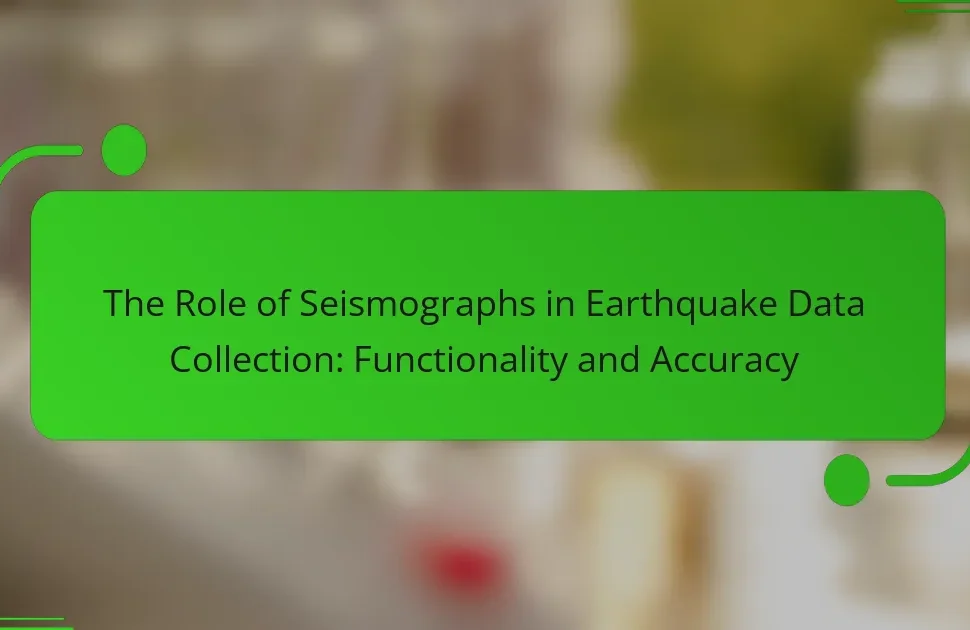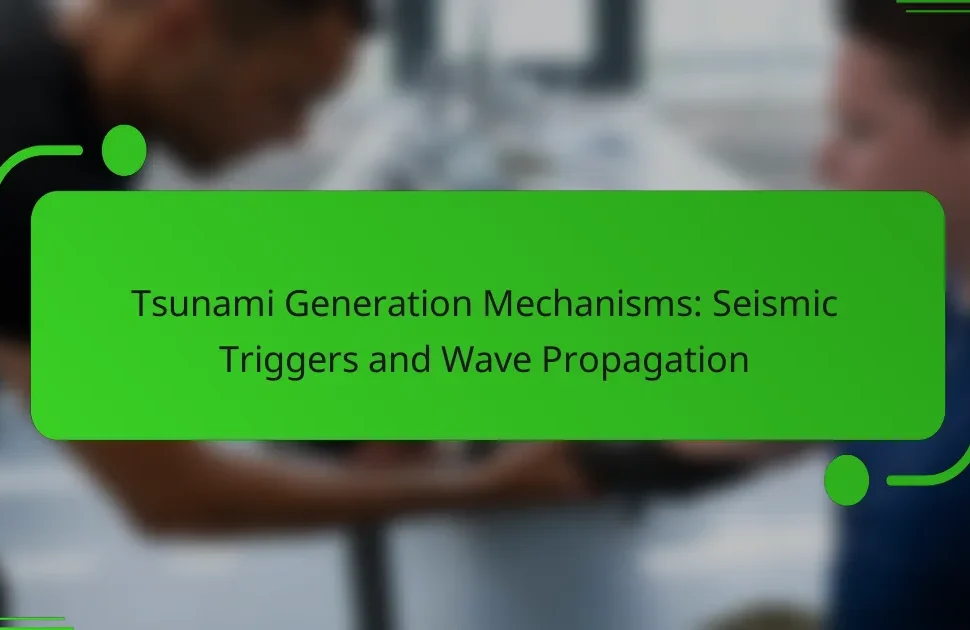Earthquake magnitude is a critical measure of the energy released during seismic events, quantifying their size and potential impact. The Richter scale is the most commonly used method for calculating magnitude, where each whole number increase signifies a tenfold rise in amplitude and approximately 31.6 times more energy release. This article explores the implications of earthquake magnitude on damage assessment, emergency response, and urban planning, highlighting the correlation between magnitude levels and destruction. Recent advancements in seismic technology, including improved sensors and machine learning algorithms, enhance the accuracy of magnitude measurements and contribute to better preparedness strategies for future earthquakes.
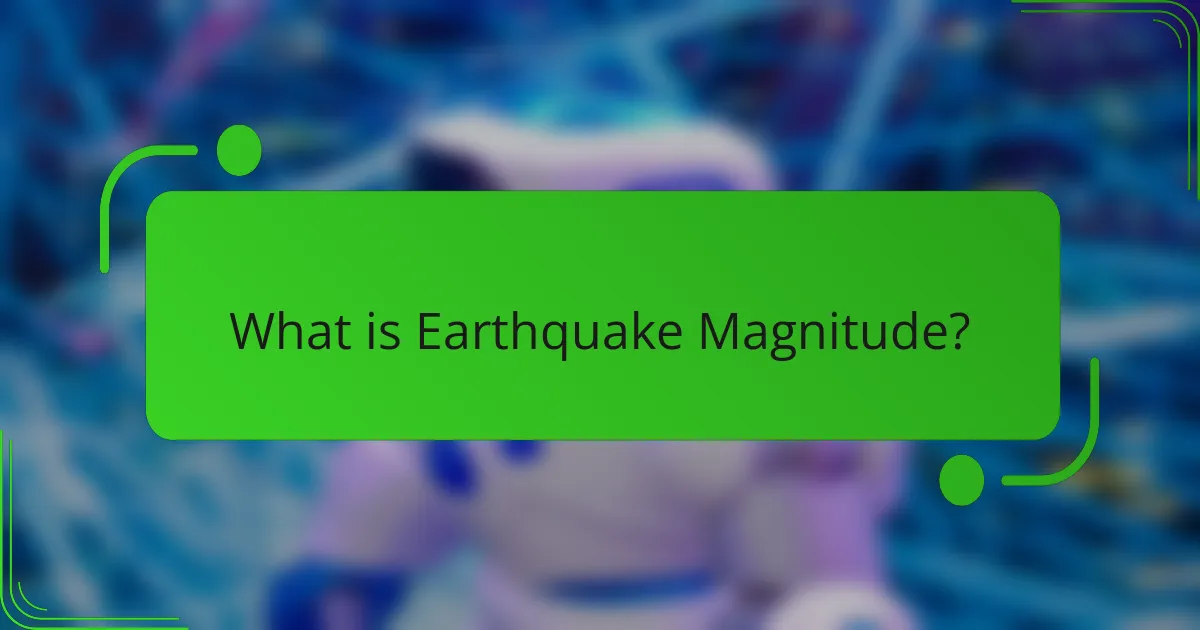
What is Earthquake Magnitude?
Earthquake magnitude is a measure of the energy released during an earthquake. It quantifies the size of the seismic event. Magnitude is typically calculated using data from seismic waves recorded by seismographs. The most common scale for measuring magnitude is the Richter scale. Each whole number increase on the Richter scale represents a tenfold increase in measured amplitude. It also corresponds to approximately 31.6 times more energy release. For example, a magnitude 5 earthquake releases over 31 times more energy than a magnitude 4 earthquake. Magnitude helps in assessing the potential damage and impact of an earthquake.
How is Earthquake Magnitude defined?
Earthquake magnitude is defined as a measure of the energy released during an earthquake. It quantifies the size of the earthquake using a logarithmic scale. The most commonly used scale is the Richter scale. This scale assigns a single number to quantify the energy released. Each whole number increase on the scale represents a tenfold increase in measured amplitude. For example, a magnitude 6 earthquake has ten times the wave amplitude of a magnitude 5 earthquake. Additionally, the moment magnitude scale (Mw) is often used for larger earthquakes. This scale provides a more accurate measure across a wider range of earthquake sizes. The magnitude is determined from seismic data recorded by seismographs.
What are the key scales used to measure Earthquake Magnitude?
The key scales used to measure earthquake magnitude are the Richter scale, the Moment Magnitude scale (Mw), and the Modified Mercalli Intensity scale. The Richter scale quantifies the size of an earthquake based on the amplitude of seismic waves. It was developed in 1935 by Charles F. Richter. The Moment Magnitude scale (Mw) is more widely used today. It measures the total energy released by an earthquake, providing a more accurate assessment for large events. The Modified Mercalli Intensity scale measures the intensity of shaking based on human observations and structural damage. Each of these scales serves a specific purpose in understanding and interpreting earthquake events.
Why is understanding Earthquake Magnitude important?
Understanding earthquake magnitude is important for assessing the potential impact of seismic events. Magnitude indicates the energy released during an earthquake. It helps in predicting the level of shaking and damage expected in affected areas. Accurate magnitude measurements inform emergency response strategies. They guide infrastructure design and urban planning to mitigate risks. Historical data shows that larger magnitude earthquakes correlate with more severe consequences. For instance, the 2010 Haiti earthquake had a magnitude of 7.0, resulting in extensive destruction and loss of life. Understanding magnitude is crucial for public safety and preparedness.
What factors influence Earthquake Magnitude?
The factors that influence earthquake magnitude include the amount of energy released during the quake, the depth of the earthquake, and the geological characteristics of the surrounding area. Energy release is measured in terms of seismic waves generated by the fault movement. Deeper earthquakes typically result in lower surface magnitudes due to distance from the surface. Geological factors include rock type and fault structure, which affect how energy propagates. Historical data shows that larger faults tend to produce higher magnitude earthquakes. For instance, the 2011 Tōhoku earthquake released an estimated energy equivalent to 600 million tons of TNT, resulting in a magnitude of 9.0.
How do seismic waves relate to Earthquake Magnitude?
Seismic waves are directly related to earthquake magnitude. Earthquake magnitude measures the energy released during an earthquake, which generates seismic waves. These waves travel through the Earth and are recorded by seismographs. The amplitude of seismic waves correlates with the earthquake’s magnitude on the Richter scale or moment magnitude scale. Higher amplitude waves indicate a greater release of energy. For example, a magnitude 5 earthquake produces seismic waves with larger amplitudes than a magnitude 4 earthquake. Therefore, analyzing the seismic wave data allows scientists to determine the earthquake’s magnitude accurately.
What role does the depth of the earthquake play in its magnitude?
The depth of an earthquake significantly influences its magnitude. Deeper earthquakes generally release energy over a larger area. This can result in a lower perceived magnitude at the surface. Shallow earthquakes tend to cause more damage due to their proximity to the surface. For instance, a magnitude 6.0 earthquake at 10 km depth can feel stronger than the same magnitude at 100 km depth. The energy disperses more as depth increases, affecting surface shaking. Studies show that the depth impacts how seismic waves travel. Thus, depth is a critical factor in understanding earthquake magnitude and its effects.
How is Earthquake Magnitude calculated?
Earthquake magnitude is calculated using data from seismic waves recorded by seismographs. The most common scale is the Richter scale, which measures the amplitude of seismic waves. Each unit increase on this scale represents a tenfold increase in wave amplitude. Another scale, the Moment Magnitude scale, considers the seismic moment, which includes fault area and slip. This scale provides a more accurate measure for large earthquakes. Seismologists analyze the time it takes for P-waves and S-waves to reach the seismograph. They also assess the energy released during the quake. These calculations help determine the earthquake’s magnitude with precision.
What mathematical formulas are used to determine magnitude?
The mathematical formulas used to determine magnitude primarily include the Richter scale and the moment magnitude scale (Mw). The Richter scale calculates magnitude using the formula: M = log10(A) + (3 log10(8Δt) – 2.92), where A is the amplitude of seismic waves. The moment magnitude scale is defined as Mw = (2/3) log10(M0) – 10.7, where M0 is the seismic moment. These formulas quantify the energy released during an earthquake. The Richter scale is more suited for smaller quakes, while the moment magnitude scale provides a more accurate measure for larger events. Historical data supports the reliability of these formulas in assessing earthquake strength.
How do different scales (e.g., Richter, Moment Magnitude) compare in calculations?
The Richter scale and Moment Magnitude scale both measure earthquake magnitude but differ in their calculations. The Richter scale calculates magnitude based on seismic wave amplitude and distance from the earthquake’s epicenter. It is most effective for small to medium earthquakes. Conversely, the Moment Magnitude scale measures the total energy released by an earthquake, considering the area of the fault that slipped and the amount of slip. This scale is more accurate for larger earthquakes. Research has shown that Moment Magnitude provides a consistent measurement across a wider range of earthquake sizes. The Moment Magnitude scale has largely replaced the Richter scale in scientific use due to its reliability in various seismic conditions.
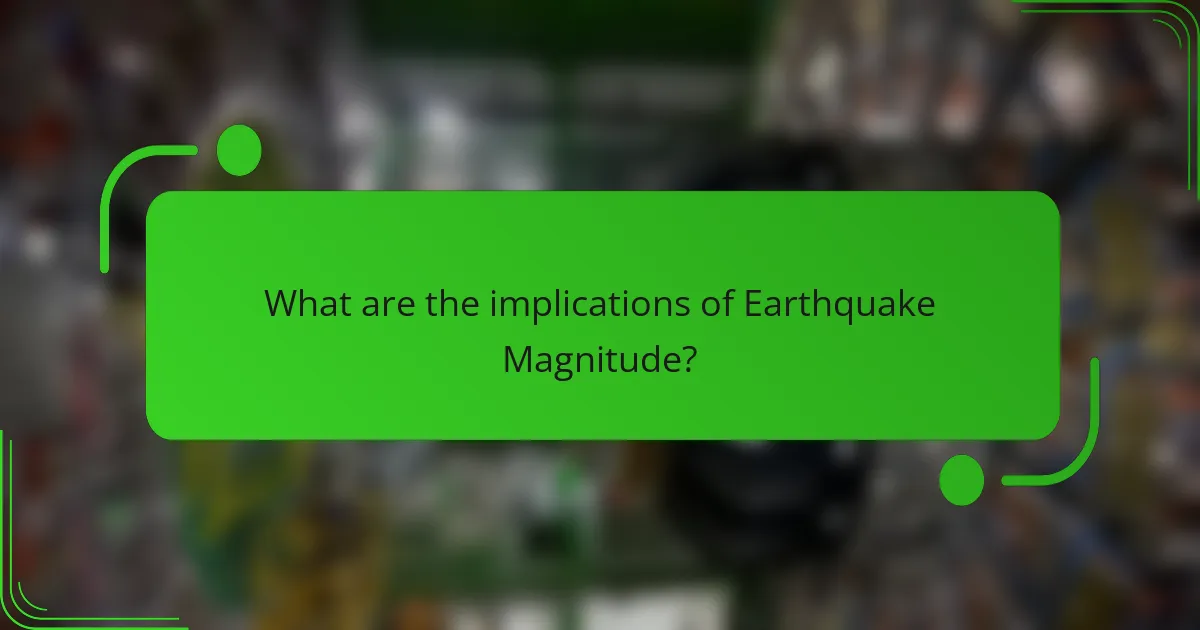
What are the implications of Earthquake Magnitude?
Earthquake magnitude indicates the energy released during an earthquake. Higher magnitudes correlate with increased destruction and risk to life. For instance, a magnitude 5 earthquake can cause moderate damage, while a magnitude 7 can lead to severe damage and casualties. Magnitude also affects emergency response strategies and resource allocation. Seismologists use magnitude scales, like the Richter scale, to assess potential impacts. Public awareness of magnitude can influence preparedness and resilience. Historical data shows that magnitude directly influences building codes and urban planning. For example, the 2010 Haiti earthquake, with a magnitude of 7.0, resulted in catastrophic consequences, highlighting the importance of magnitude in disaster management.
How does Earthquake Magnitude affect safety measures?
Earthquake magnitude significantly influences safety measures. Higher magnitude earthquakes require more robust safety protocols. For instance, earthquakes measuring 6.0 or higher often lead to building evacuations. Emergency response plans are activated based on the magnitude. Magnitudes above 7.0 trigger immediate alerts for potential tsunamis. Safety drills and public education increase with the frequency of high-magnitude events. Historical data shows that regions experiencing frequent high-magnitude earthquakes invest in better infrastructure. For example, California has strict building codes due to its seismic activity. These measures aim to reduce casualties and property damage during significant earthquakes.
What precautions should be taken based on different magnitudes?
Precautions vary based on earthquake magnitudes. For magnitudes below 4.0, minimal precautions are needed. People should be aware of their surroundings. For magnitudes between 4.0 and 5.0, securing heavy furniture is advisable. Individuals should also have an emergency kit ready. For magnitudes between 5.0 and 6.0, evacuation plans should be established. Residents should practice drop, cover, and hold on drills. For magnitudes above 6.0, immediate evacuation to open areas is crucial. Emergency services should be contacted, and communication plans must be in place. The U.S. Geological Survey advises these precautions to minimize injuries and fatalities.
How does magnitude influence emergency response efforts?
Magnitude directly influences emergency response efforts by determining the scale and urgency of the response required. Higher magnitude earthquakes typically result in more severe damage and greater casualties. For instance, a magnitude 7.0 earthquake can cause widespread destruction, necessitating immediate deployment of rescue teams and medical assistance. In contrast, a magnitude 4.0 event may lead to minimal damage and localized response. The United States Geological Survey (USGS) indicates that response plans are often tiered based on magnitude thresholds. This ensures that resources are allocated efficiently and effectively. Additionally, magnitude affects public awareness and preparedness levels, influencing how communities react during an emergency.
What are the social and economic impacts of Earthquake Magnitude?
Earthquake magnitude significantly influences social and economic impacts. Higher magnitude earthquakes typically result in more severe damage and loss of life. For instance, the 2010 Haiti earthquake, with a magnitude of 7.0, caused approximately 230,000 deaths and massive infrastructure destruction. This level of devastation leads to long-term social issues, including displacement and trauma among affected populations. Economically, higher magnitude earthquakes can disrupt local and national economies, leading to costly rebuilding efforts. The 1994 Northridge earthquake in California, with a magnitude of 6.7, resulted in an estimated $44 billion in damages. Such economic impacts can hinder growth and development for years. Overall, the magnitude of an earthquake directly correlates to the extent of its social and economic repercussions.
How can magnitude affect community resilience?
Magnitude can significantly affect community resilience by influencing the level of damage and disruption caused by an earthquake. Higher magnitude earthquakes typically result in more severe structural damage. This damage can lead to loss of infrastructure, which impairs emergency response capabilities. Communities with stronger buildings and preparedness plans tend to recover more quickly. Conversely, lower magnitude earthquakes may cause less damage, allowing for faster recovery. Research indicates that communities with effective disaster preparedness strategies can enhance resilience regardless of magnitude. For instance, a study by the United Nations Office for Disaster Risk Reduction highlights that preparedness reduces recovery time after significant seismic events.
What are the financial costs associated with high-magnitude earthquakes?
High-magnitude earthquakes can incur substantial financial costs. These costs include damage to infrastructure, homes, and businesses. For instance, the 1994 Northridge earthquake in California caused approximately $44 billion in damages. Economic losses also arise from business interruptions and loss of productivity. Recovery and rebuilding efforts can take years, further increasing financial burdens. Insurance claims often reach into the billions, straining financial systems. Additionally, high-magnitude earthquakes can lead to long-term economic downturns in affected regions. The overall financial impact can significantly affect local and national economies.
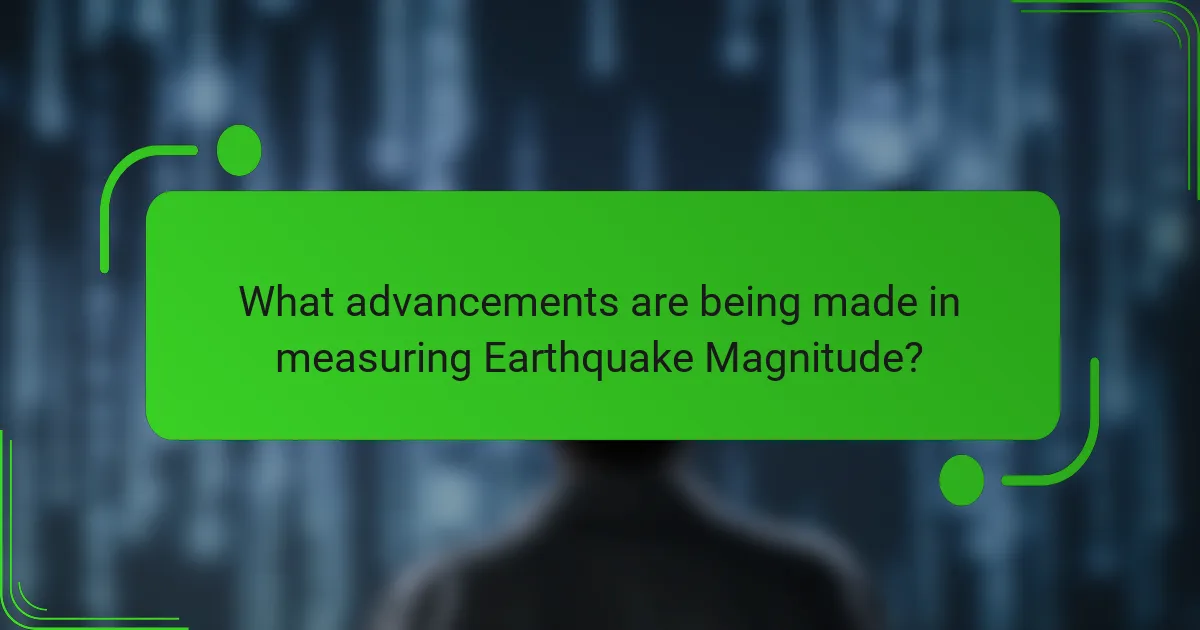
What advancements are being made in measuring Earthquake Magnitude?
Recent advancements in measuring earthquake magnitude include improved seismic sensors and data analysis techniques. Modern sensors can detect smaller tremors with greater accuracy. These sensors utilize digital technology for enhanced signal processing. Machine learning algorithms are increasingly applied to analyze seismic data. This allows for real-time processing and quicker magnitude calculations. Researchers are also developing new scales to better quantify earthquake impact. For example, the Moment Magnitude Scale (Mw) is now widely used for its accuracy across different magnitudes. These advancements contribute to better earthquake preparedness and response strategies.
How are technology and research improving magnitude measurements?
Technology and research are enhancing magnitude measurements through advanced seismic sensors and data analysis techniques. Modern seismic sensors provide higher sensitivity and accuracy in detecting ground movements. These sensors can capture a wider range of frequencies associated with seismic waves. Improved data analysis algorithms enable quicker and more precise calculations of magnitude. Machine learning techniques are also being utilized to interpret seismic data more effectively. Research studies, such as those conducted by the United States Geological Survey (USGS), validate these advancements. For instance, the development of the ShakeAlert system allows for real-time earthquake detection and magnitude assessment. This system uses a network of seismic stations to provide immediate alerts. Overall, these innovations lead to better preparedness and response to seismic events.
What new tools are being developed for more accurate measurements?
New tools being developed for more accurate measurements of earthquake magnitude include advanced seismic sensors and machine learning algorithms. These seismic sensors offer higher sensitivity and can detect smaller tremors. Machine learning algorithms analyze vast amounts of seismic data to improve prediction accuracy. Additionally, satellite-based technologies are being utilized to measure ground displacement with precision. Research indicates that these innovations can enhance real-time monitoring capabilities. For instance, the USGS is integrating these technologies to refine earthquake early warning systems. Overall, these tools represent significant advancements in the field of seismology, leading to better preparedness and response strategies.
How does real-time data contribute to understanding magnitude?
Real-time data enhances the understanding of earthquake magnitude by providing immediate information on seismic activity. This data includes the location, depth, and intensity of earthquakes as they occur. By analyzing this information, scientists can calculate the magnitude using established scales like the Richter or Moment Magnitude Scale. Real-time data allows for rapid updates to magnitude estimates as new information becomes available. For instance, the United States Geological Survey (USGS) utilizes real-time data to issue alerts and refine magnitude assessments within minutes of an earthquake. This capability improves public safety and response efforts during seismic events.
What practical tips can help individuals prepare for earthquakes based on magnitude?
To prepare for earthquakes based on magnitude, individuals should assess their risk level. For minor earthquakes (magnitude 1-3), securing heavy furniture and keeping emergency supplies is sufficient. For moderate earthquakes (magnitude 4-5), individuals should create an emergency plan and practice drop, cover, and hold on drills. For strong earthquakes (magnitude 6-7), reinforcing structures and having a family communication plan is crucial. In the case of major earthquakes (magnitude 8 and above), individuals should consider relocating to a safer area and investing in earthquake insurance. These preparations help mitigate risks and enhance safety during seismic events.
Earthquake magnitude is a critical measure of the energy released during seismic events, quantified primarily using the Richter and Moment Magnitude scales. This article explores the definitions, calculations, and key scales used to assess earthquake magnitude, emphasizing its importance in predicting potential damage and guiding emergency response strategies. Factors influencing magnitude, such as depth and geological characteristics, are examined alongside the implications for social and economic impacts. Additionally, advancements in technology and real-time data analysis are highlighted as crucial for improving measurement accuracy and enhancing preparedness.



